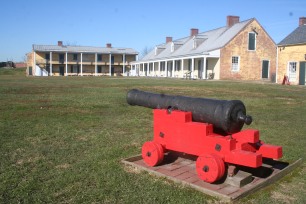I took my kids to see the AAA-affiliated Iron Pigs play at Coca-Cola Park for the first time this summer. We all had a blast, thanks to the festive easiness of the whole experience. Here are some subjective highlights to keep in mind before you go:

There is no bad seat. We debated over seats like some MLB coaches mull over first-round draft picks. It was unnecessary. Ticket prices range from $8 for lawn seating to $11 for just about every other seat. We ended up in the second row next to the dugout of the opposing team. My son, who brought his glove, didn’t get a coveted foul ball, but right fielder Austin Listi tossed him one between innings, which thrilled him. Next time, we might try the Bacon Strip, two levels of seats along the right field wall, modeled after the famous “Green Monster” seats of Fenway Park.
Try the food at least once. Not surprisingly, the food kiosks take full advantage of the team’s pork-themed name. Menu highlights include deep-fried bacon skewers, pork-roll burgers, BBQ pulled pork with mac ‘n’ cheese and mashed potatoes, bacon-wrapped hot dogs, and maple bacon funnel cake. It’s all as pricey as you might expect, but it was a fun experience. Next time, though, we might eat at Friendly’s (2.2 miles away) before going to the game, and we’ll definitely skip the refrigerated chocolate-covered bacon.
The name Iron Pigs is a nod to the steel industry that once dominated the Lehigh Valley. When the team first arrived in Allentown from Canada in 2008, the local newspaper sponsored a contest to give them a new name (the Ottawa Lynx just didn’t seem right). It received 3,500 suggestions and narrowed it down to eight; IronPigs won handily in the final round of voting. It’s a deliberate twist on pig iron, the raw iron that gets melted down to make steel. (The pig reference comes from a long-ago observation that the rows of conveyor-belt ingots resemble a litter of piglets.)

Don’t bring water. That’s the warning. Security will make you leave it at the door. They’re pretty strict about it, though they might let you get away with a Dasani bottle, the brand they sell inside. So hydrate before the game, or resign yourself to shelling out a few bucks or searching out the water fountains.
It’s pretty much impossible not to have fun. From the Oink On! screen shots and T-shirt cannonballs between innings, to the overall buoyancy of the crowd, it’s hard not to get swept up in it all. Just about every home game has a theme or giveaway, like Bring your Dog and Christmas in July. This summer, “Jurassic Pork” night featured fireworks and a cap giveaway, while “The Office” night attendees got Stanley Hudson IronPigs bobbleheads (along with an appearance by the actor who plays him).
Can’t wait to see what next season brings.




























![dsc_0371[1]](https://exploringpennsylvania.files.wordpress.com/2013/02/dsc_03711.jpg?w=300&h=199)







![ben-franklin-museum-ext-600[1]](https://exploringpennsylvania.files.wordpress.com/2013/09/ben-franklin-museum-ext-6001.jpg?w=300&h=200)
![franklin-ghost-house-600[1]](https://exploringpennsylvania.files.wordpress.com/2013/09/franklin-ghost-house-6001.jpg?w=300&h=200)
![village-greens-miniature[1]](https://exploringpennsylvania.files.wordpress.com/2013/07/village-greens-miniature1.jpg?w=224&h=300)
![villagegreens[1]](https://exploringpennsylvania.files.wordpress.com/2013/07/villagegreens1.gif?w=450)
